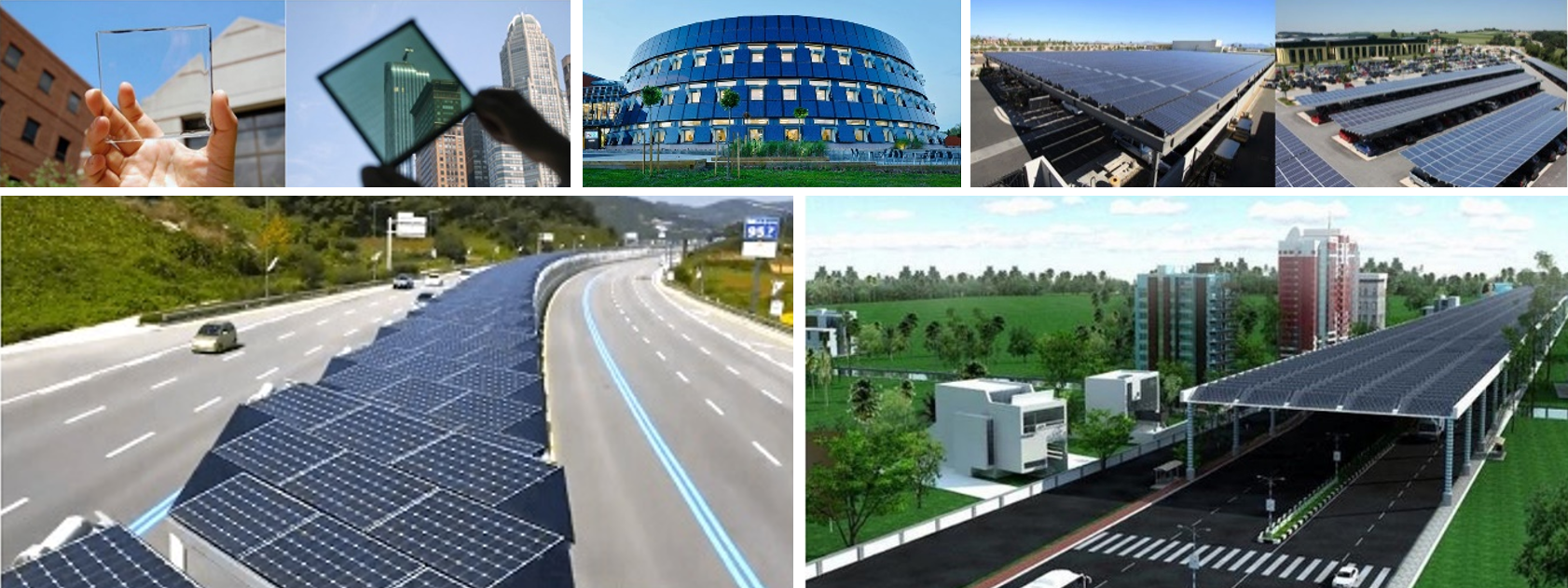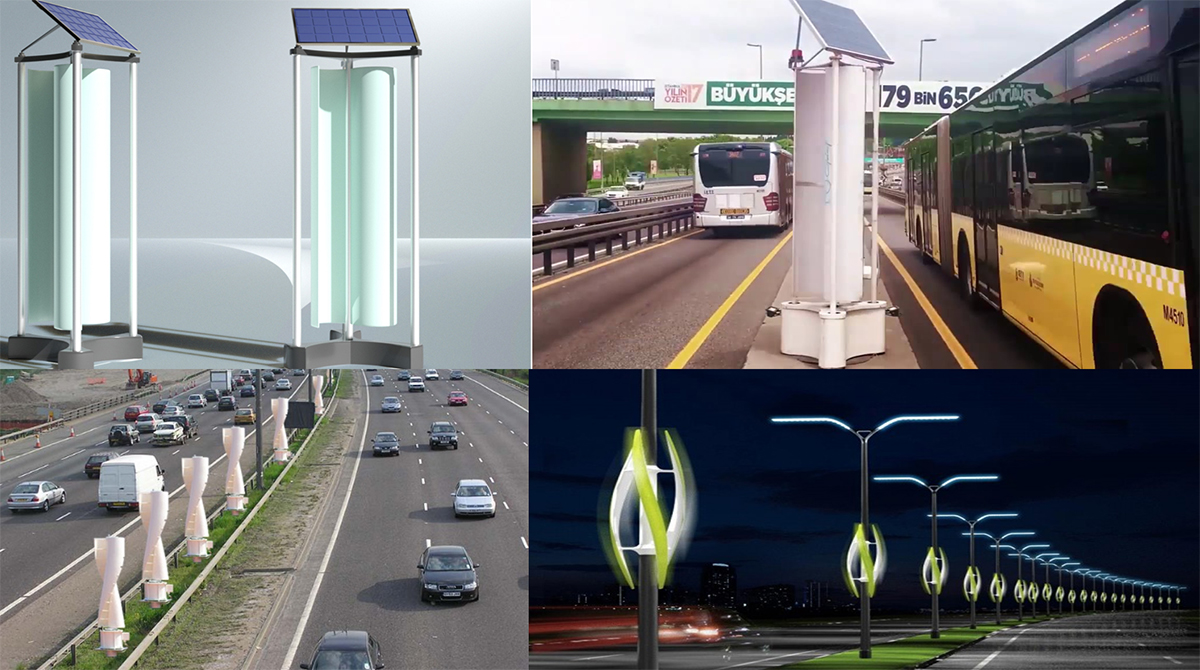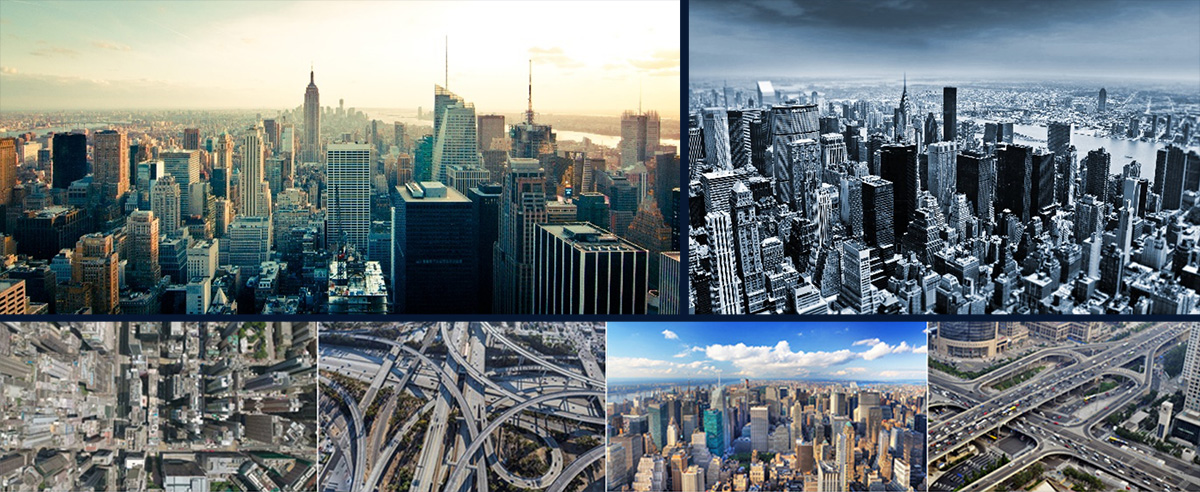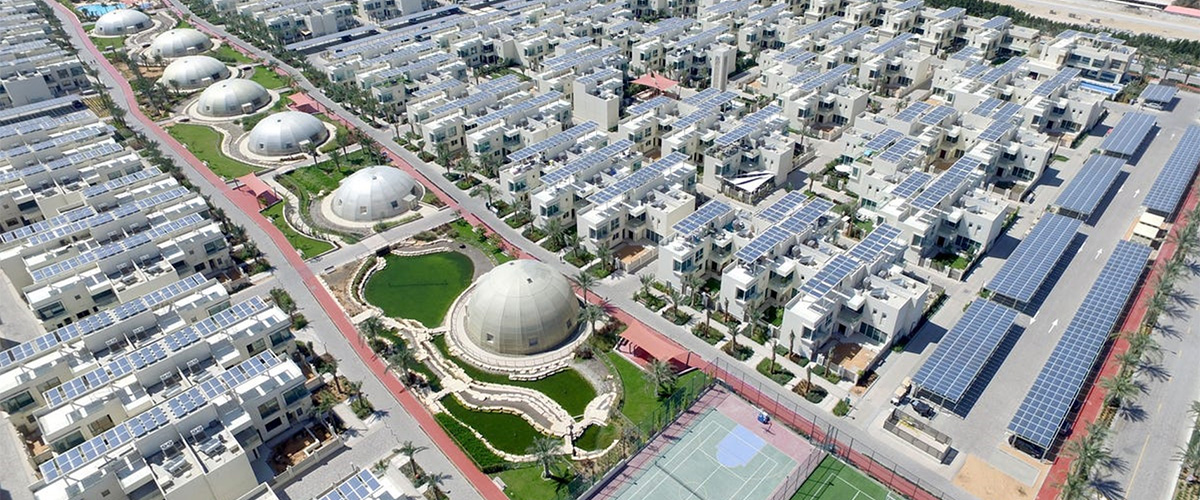In the context of solar power, municipalities present billions of square feet of sun-exposed surface area nationwide that can be covered with photovoltaic panels, which are today both inexpensive and flexible in deployment. Going beyond rooftops, photovoltaic panels can be installed within the windows and siding of buildings, on the sides of bridges and overpasses, and on top of canopies over parking lots, highways, road medians and bike paths. Nearly every aspect of municipal infrastructure can today be seamlessly integrated with a means generate power from the sun.

Top-left to bottom-right: 1). Clear photovoltaic glass. 2). Green photovoltaic glass. 3). Solar-sided building. 4) + 5). Solar canopies over parking lots. 6). Highway median converted to solar-canopied bike path. 7) Solar highway canopy.

Concept of comprehensive solar integration with municipal infrastructure.
Wind, too, can be similarly integrated. As wind power has evolved from skyscraper-sized turbines that are hallmarks of traditional wind farms, small modular turbines can today be deployed alongside solar panels within the thousands of miles of highway medians surrounding America’s cities. As highway medians are flat, straight and municipally owned, they collectively present billions of additional square feet that are effectively free to deploy wind at scale – which in this context can be significantly boosted by air movement from passing vehicles.

Modular, mass-produced wind turbines powered by vehicle traffic at the medians of highways.
It is difficult to overstate the potential scale of energy generation made possible by targeting municipal infrastructure as a deployment vector for renewable power. This is not only because it offers an unrivaled expanse of cost-free surface area and flexibility of location, but also because this approach solves most of the challenges facing large-scale renewable deployment today. (Note: the remaining challenges of material throughput, carbon-neutral manufacturing and end-of-life recycling are dedicated roles of Scarcity Zero's second core function, Cogeneration Facilities.
-
Location / Transmission Distance: As a general rule, the farther electricity must travel, the more challenging it becomes to transmit due to resistance in transmission mediums (normally, power lines). While the American Southwest has enough open space to power the entire planet through photovoltaic panels, electrical resistances in power lines make it unfeasible to transmit electricity over long distances. Such an effort would also be cost-prohibitive, as high-tension power lines cost millions of dollars to build per-mile even if capable of resistance-free transmission. This makes renewables most effective in locations close to where their generated energy is consumed, of which cities are the zenith as they consume the most energy in the most compact envelope.
-
Land Costs: As the effectiveness of renewables is inversely proportional to transmission distance, integrating them within city infrastructure avoids the corresponding problem of land costs. Not every state has cheap open space to deploy solar farms in the vein of California or Arizona, and as land prices tend to increase with proximity to population centers (often at six figures per-acre or greater), buying the billions of acres required to implement renewables at sufficient scale would requisitely cost staggering sums. Municipal integration avoids this problem because municipal governments need neither purchase land nor seek permission to install renewable power on public property. They further have the power to incentivize new construction to integrate renewable power from the design stage in both public and private development. Municipal integration can thus automatically avoid one of the most significant cost factors of large-scale renewable deployment.
-
Intermittency: Integrated renewables can further address the problem of intermittency (instant availability) within population centers and their surrounding regions. The present-day use of renewables requires complex networks of power systems to meet energy demand when renewables (which do not work 24 hours a day) are unable to do so. This configuration contributes to a messy, failure-prone and oft-unreliable power grid that is at risk of failure in critical times of stress – or sabotage from malfeasant actors. With Renewable Cities, the city infrastructure itself becomes the city’s primary power source. In this model, a city would not need to rely on energy generated by external sources (outside of storage through The National Aqueduct), instead providing for their own needs and only consuming energy from external sources when required. This is a marked improvement from constantly relying on remote renewable farms – and then relying on carbon-emitting backup systems thereafter – if and when those farms generate insufficient power.
-
Scalability: As the effectiveness of renewables is inversely proportional to transmission distance, integrating them within city infrastructure avoids the corresponding problem of land costs. Not every state has cheap open space to deploy solar farms in the vein of California or Arizona, and as land prices tend to increase with proximity to population centers (often at six figures per-acre or greater), buying the billions of acres required to implement renewables at sufficient scale would requisitely cost staggering sums. Municipal integration avoids this problem because municipal governments need neither purchase land nor seek permission to install renewable power on public property. They further have the power to incentivize new construction to integrate renewable power from the design stage in both public and private development. Municipal integration can thus automatically avoid one of the most significant cost factors of large-scale renewable deployment.

Expanses of American cities, reflecting only a fraction of national urban landscapes.
Beyond addressing these challenges, integrating renewables within municipal infrastructure turns each individual panel or turbine into a node that in aggregate helps underwrite a smart, redundantly reinforced electric grid. At maximum scale, every building, parking lot, highway median, bridge, overpass and all points in between become a means to both generate and transmit electricity – which, when connected, can upgrade and eventually replace the antiquated electric grids that are today struggling to keep up with our ever-advancing society.
As of this writing, our national electric grid is comprised of 7,600+ decentralized power plants that are owned by 3,200+ competing utility companies that transmit electricity through 450,000+ miles of high voltage power lines, relay stations and transformers – effectively a convoluted mess. This arbitrary deployment of infrastructure does not operate within a cohesive, dynamic and scalable framework, nor does it utilize cooperating systems that are mass-manufactured to a modular standard for rapid installation and replacement. This contributes to the problem of power shortages and regional blackouts, which is getting worse over time as our existing electric grids decay. The currently estimated cost to upgrade them using today’s technology exceeds $2 trillion. Integrating renewables within municipal infrastructure can effectively solve this problem at a far superior return on investment across all relevant metrics.
Further, the combination of these aforementioned factors accomplishes two important goals:
-
It transforms cities into power-generating centers.Once cities scale renewable integration to the point where they can generate more energy than they consume, they functionally become power plants. With the ability to store energy generated by renewables within The National Aqueduct, cities can thereafter contribute to a national energy abundance instead of drawing from external power infrastructure to meet their own energy needs.
For example: Miami-Dade County in South Florida spans an area of 2,431 square miles, 1,898 of which is land. It assessed a net energy consumption of 132.13 billion kilowatt-hours in 2018. Using rationale explained in the following citation, we assess that one square mile of solar panel surface can reliably generate 836.5 million kilowatt-hours of energy per-year. That means Miami-Dade County would only have to integrate solar panels within 159 square miles of its land area – less than 8% – to become energy independent, assuming that The National Aqueduct could provide sufficient power off-hours. At 10% integration, the county generates more energy than it consumes. At 15%, it’s a power plant, one with multiplied output should integration reach beyond that – all the more so as the efficiency of renewables improves over time.
-
It drastically increases power generation capacity. With cities powered by integrated renewables and the energy they help contribute to The National Aqueduct, any external power generation capacity thereafter enters a dynamic with drastically reduced demand. As additional power infrastructure is deployed, it increases generating capacity accordingly – at scale powering a multiplier effect where generating capacity continues to accelerate at a significantly faster rate. As the cost of energy is relational to demand, these circumstances cause the price of electricity to sharply reduce. This presents significant benefits across nearly all sectors of our economy, while also making dedicated resource production, environmental cleanup and carbon capture far less expensive.
This is where Cogeneration Facilities – Scarcity Zero’s second core function – enter the framework. As a cooperative deployment of modular, mass-produced systems that can be rapidly installed (or replaced), their intent is to eclipse our current generating capacity several times over while also powering systems that produce vital resources, extract greenhouse gasses, and recycle waste – all while providing a carbon-neutral energy source to mass-manufacture renewables.

Solar City in Dubai
